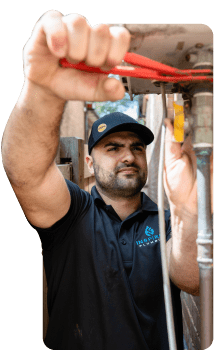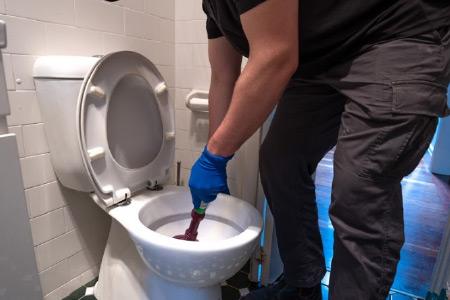we're open

Book now
Click to book a plumber
02 9158 3565
24/7 emergency service
Click here for
a free quote
a free quote









There are a whole host of things that can go wrong with your toilet, and toilet repair involves more than just the occasional clogged drain. Once a toilet is a few years old, its parts can suffer from wear and tear and need replacing. While a toilet’s porcelain body is sturdy, its internal parts (the bits you can’t see), like most moving parts, are quicker to wear out.
Eventually, even the toilet body itself will need to be replaced, but if it’s properly maintained, and unless it’s damaged somehow, it should last at least 10 years.
If you have a continually running toilet or it leaks from your toilet, you probably need a plumber to figure out what’s going on and address it. If the tank isn’t filling after a flush or not filling completely, that could indicate another problem.
A blocked toilet might not be clogged inside the toilet. The blockage could be farther down the line and needs to be resolved by a plumber. If your toilet has been filling with hot water, that too is probably something for a plumber to handle.
For any toilet problem you’re dealing with, remember, we’re highly recommended for our customer service when it comes to plumbing issues. Contact us for an enquire.









The below are some of the common parts of a toilet that can give out, and cause you a real headache.
The silicone sealant at the base of the toilet, where it meets the floor, is the source of the most unpleasant toilet leaks. These leaks can go straight onto the bathroom floor and beneath it into the subfloor.
Water on the floor can come from the bowl or the drain, causing sanitation concerns. However, it also might be due to condensation that’s formed on the outside of the toilet. You also should check the bolts that anchor the toilet to the base in case they’ve loosened.
Replacing the ring that forms a toilet’s seal will be difficult and shouldn’t be a DIY project. You don’t want to break the toilet accidentally when lifting or moving it. Most people would agree that professional plumbers should do this project.
The flush valve triggers the outlet valve to open and empty a full toilet bowl when the handle is pressed down and released. This valve, especially when made of plastic, is easily corroded and can leak out, preventing the valve from being activated.
The outlet valve itself could be the cause of a leak as well since the hard rubber it’s made of can easily harden or corrode, causing water to seep past it and down the drain.
This is one reason a toilet will flush repeatedly or constantly leak water into the pan.
The outlet valve seals a toilet’s drain opening -- a process that should happen automatically when you flush. However, hard water and cleaning chemicals can shorten its life considerably through hardening or corrosion. You’ll know when the outlet valve is no longer able to do its job when the tank keeps emptying and the toilet flushes repeatedly while trying to refill.
A toilet’s fill valve is what lets fresh water into the tank to refill it following a flush. Many modern styles of toilets use fill valves with wrap-around cups. These have replaced the floats used in older systems (floats are hollow balloon-shaped objects that control a toilet’s water level).
If your fill valve wears out, a new one costs very little when you buy it for DIY. It can be tricky to install, though, so you should consider hiring a professional plumber for this job. While doing it, the plumber also might discover some other toilet parts that need repair or replacement, and they will be able to carry out some preventative maintenance.
When the water in the tank drops low enough, the toilet float (the balloon-like device in the tank) drops onto a lever, thereby opening the fresh water valve to refill the tank.
Once the float actually floats back up to a certain point, the water shuts off.
The siphon is the mechanism that keeps the bowl’s water level consistent. You can tell it’s working by pouring water into the bowl and noting that this doesn’t change the water level. The siphon naturally keeps the water in the bowl at its level.
This is why you can still flush your toilet, using a bucket of water, when the plumbing has been shut off.
The toilet bowl, of course, is where the waste goes. The bowl would hold about twice as much water as the tank, but, unless it’s a blocked toilet, the bowl never fills more than about halfway.
The toilet rim is simply the top of the bowl. It’s where the replaceable toilet seat and lid are attached.
This part of the toilet can't really contribue to blockages, and doesn't play any role in your blocked toilet.




Hot water in the toilet is surprising (maybe even a pleasant surprise on a cold morning), but it also indicates that something is amiss. The hot water could be caused by one of a few things. First, if it’s a new home, the hot and cold-water valves might have been accidentally fitted the wrong way around.
If you encounter this, you should call a plumber to diagnose the problem and do whatever type of toilet repair is needed.
Generally speaking, toilets (the porcelain parts of them, that is) need to be replaced every 15 years on average. This can be for cosmetic reasons, such as staining or chipping, it could be an outdated model, or you might need a different size or design to fit your bathroom following a remodel.
One reason some toilets need to be replaced is the limescale that’s built up over the years. This can get so thick that it blocks water from properly flowing down the sides of the bowl following a flush, meaning the flush doesn’t work effectively. If your toilet is doing this, we strongly recommend you consider an upgrade, or at the very least, try and get rid of that limescale build up.
If you don’t know what’s wrong with your toilet or how to fix it, call us at Inspired Plumbing!
We understand how toilets work and the weird things they can do when broken (such as flushing repeatedly, or any number of weird and wonderful things – we’ve seen it all over the years).
Most toilets are simple in their construction, but with more complex interior parts. But if you’re used to working with them, like we are, the causes of their problems aren’t hard to figure out, and so we can get maintenance or a permanent repair done quickly.
Don’t stay awake all night because of a toilet that’s constantly running, dripping, or flushing. That’s what we’re here for. We’re you’re 24/7, 365 days a year toilet repair plumbers, call us today!
